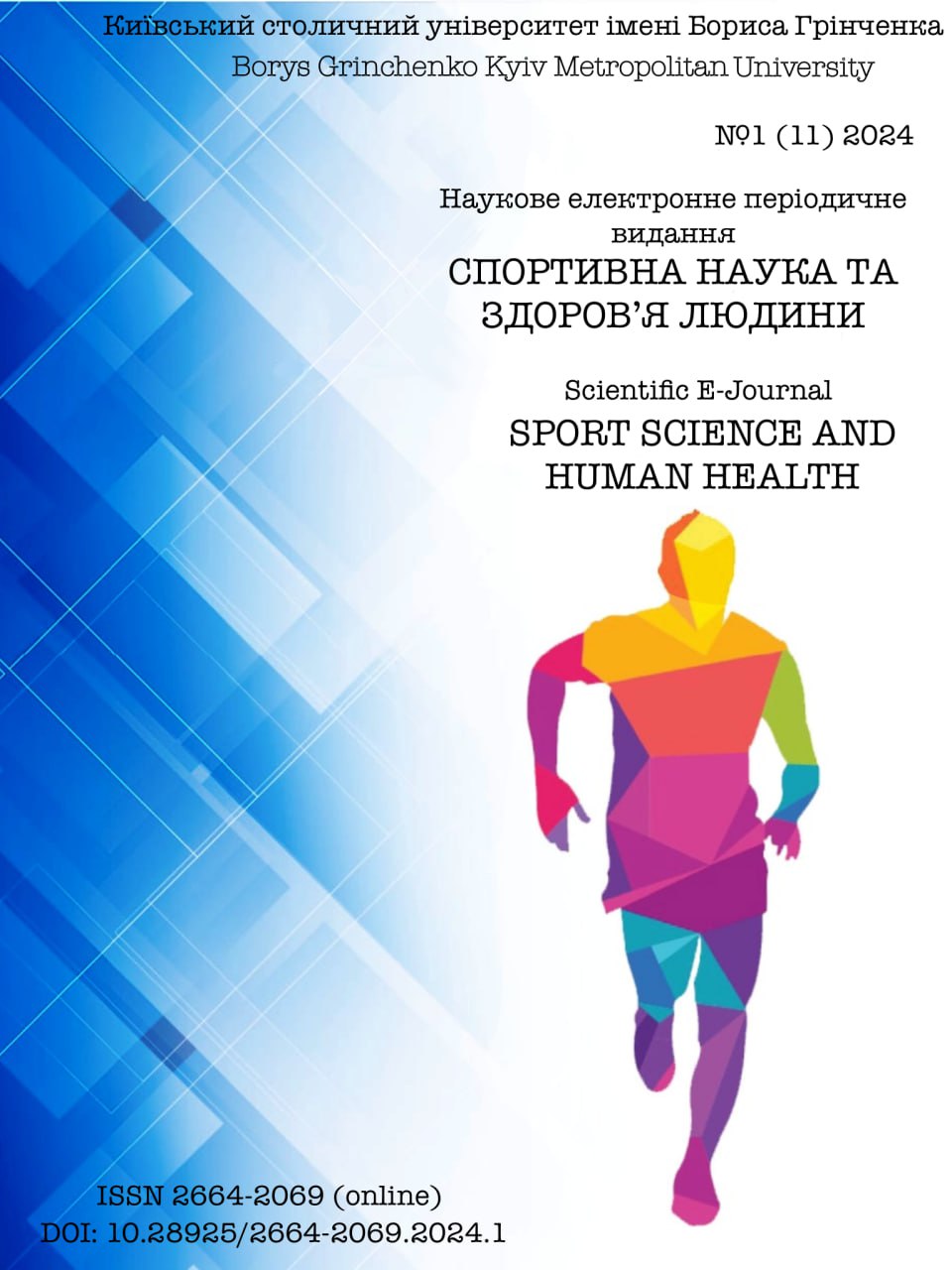МОТИВАЦІЯ ДО ЗДОРОВ’Я ТА ЇЇ ЗВ’ЯЗОК З ФУНКЦІОНАЛЬНИМ СТАНОМ КАРДІО-РЕСПІРАТОРНОЇ СИСТЕМИ, СТАТИСТИЧНИМ БАЛАНСУВАННЯМ ТА М’ЯЗОВОЮ СИЛОЮ ХВОРИХ І ЗДОРОВИХ ЛЮДЕЙ
DOI:
https://doi.org/10.28925/2664-2069.2024.13Ключові слова:
мотивація, здоров'я, кардіореспіраторна система, статистичне балансування, м'язова сила.Анотація
Актуальність. Мотивація у сучасній психології позначає систему чинників, що детермінують
поведінку людини. Існують суперечливі думки про роль мотивації у дотримуванні
здорового образу життя та збереженні здоров’я. Більшість дослідників
наполягають на важливому значенні мотивації у формуванні стану здоров’я
людини. Однак, конкретних даних про зв’язок мотивації з різники компонентами
здоров’я людини дуже мало.
Метою роботи було дослідити зв'язок мотивації з функціональним станом
кардіореспіраторної системи, статистичним балансуванням та м'язовою силою.
Матеріал і методик: 577 здорових та хворих людей. В учасників дослідження визначали
частоту серцевих скорочень у стані спокою, артеріальний тиск, систолічний та
діастолічний тиск, життєву ємність легень, тривалість затримки дихання після
глибокого вдиху та видиху, тривалість статистичної рівноваги та м'язову силу кистей
рук. Мотивацію до здоров'я досліджували за допомогою короткого опитування для
визначення локусу контролю одужання.
Результати. Серед обстежених переважав середній рівень мотивації – 55,11% (318/577); за
кількістю виявлених випадків високий рівень становив 38,65% (223/577), а низький
– 6,24% (36/577). У здорових людей переважав високий рівень мотивації до
здоров'я - 53,13% (119/224), а хворі найчастіше мали середній рівень мотивації -
62,04% (219/353). Крім того, низький рівень мотивації був притаманний хворим
людям порівняно зі здоровими.
Висновки. Особи з вищим рівнем мотивації до здоров'я мають найнижчий рівень систолічного
артеріального тиску, більшу життєву ємність легень, більшу тривалість статистичної
рівноваги та вищу за середню силу кистей порівняно з особами з нижчим рівнем
мотивації.
Посилання
Simpson EH, Balsam PD. The Behavioral Neuroscience of Motivation: An Overview of Concepts, Measures, and Translational Applications. Curr Top Behav Neurosci. 2016;27:1–12. DOI:10.1007/7854_2015_402.
Locke EA, Schattke K. Intrinsic and extrinsic motivation: Time for expansion and clarification. Motivation Science. 2019;5(4):277–290. DOI: 10.1037/mot0000116.
Kruglanski AW, Chernikova M, Jasko K. Aspects of motivation: reflections on Roy Baumeister’s essay. Motivation and Emotion. 2016;40(1):11–15. DOI: 10.1007/ s11031-015-9534-6.
Maslow AH. A theory of human motivation. Psychol Review. 1943;50:370–396. DOI:10.1037/h0054346.
Lakerveld J, Palmeira AL, van Duinkerken E, Whitelock V, Peyrot M, Nouwen A. Motivation: key to a healthy lifestyle in people with diabetes? Current and emerging knowledge and applications. Diabetic Medicine. 2020;37(3): 464–472. Available from: https://onlinelibrary.wiley.com/ doi/epdf/10.1111/dme.14228.
Berezueva T. Formation of positive motivation of applicants for basic secondary education for a healthy lifestyle. Bulletin of Luhansk Taras Shevchenko National University. Pedagogical Sciences. 2019;4(2):143–152. [in Ukrainian].
Mekhed O, Riabchenkо S, Zhara H. Youngsters' healthy lifestyle factors analysis. Bulletin of the T.H. Shevchenko National University "Chernihiv Colehium". 2019;3:262–266. Available from: http://nbuv.gov.ua/UJRN/vnuchkpn2019343 [in Ukrainian].
Kotko D, Goncharuk N, Putro L, Shevtsov S. Motor activity as the most important factor in motivating people to a healthy lifestyle. Scientific journal of the National Pedagogical Dragomanov University. Series No 15. Scientific and pedagogical problems of physical culture (physical culture and sports). 2019;4 (112):57–61. [in Ukrainian].
Yurchyshyn Y. Theoretical aspects of enhancing students’ motivation to physical activity of wellness orientation. Pedagogical Education: Theory and Practice. 2015;19(2):240–244. Available from: http://nbuv.gov.ua/UJRN/znppo_2015_19(2)_42 [in Ukrainian].
Koval О. Formation of motivations of development of physical activity in students of establishment of higher education. Bulletin of the Kamianets-Podіlskyi Ivan Ohiienko National University. Physical education, Sport and Human Health. 2020;16:32–36. [in Ukrainian].
Trigueros R, Aguilar-Parra JM, Cangas AJ, Bermejo R, Ferrandiz C, López-Liria R. Influence of Emotional Intelligence, Motivation and Resilience on Academic Performance and the Adoption of Healthy Lifestyle Habits among Adolescents. Int. J. Environ. Res. Public Health. 2019;16(16):2810. DOI: 10.3390/ijerph16162810.
Nascimento Júnior JRA, Granja CTL, Silva DB, Oliveira DV, et al. Is motivation to physical activity practice associated with the lifestyle of individuals who undergo weight training in the context of higher education? Acta Scientiarum. Health Sciences. 2018;40(1):e39109. Available from: https://www.redalyc.org/journal/3072/307259135028/html.
Lee Y-S, Laffrey SC. Predictors of physical activity in older adults with borderline hypertension. Nurs Res. Mar-Apr 2006;55(2):110–20. DOI: 10.1097/00006199-200603000-00006.
Budreyko OA, Kyrylova OO, Chumak SO. Comprehensive assessment of motivation for self-control in adolescents with type 1 diabetes mellitus. Ukrainian journal of pediatric endocrinology. 2018;2:75–84. [in Ukrainian].
Carter KF, Kulbok PA. Motivation for health behaviours: a systematic review of the nursing literature. J Adv Nurs. 2002 Nov;40(3):316–30. DOI: 10.1046/j.1365-2648.2002.02373.x.
Williams DM, Rhodes RE. The confounded self-efficacy construct: conceptual analysis and recommendations for future research. Health Psychol Rev. 2016 Jun;10(2):113–28. DOI:10.1080/17437199.2014.941998.
Wiesemann A, Ludt S, Szecsenyi J, Scheuermann W, Scheidt R. Cardiovascular risk factors and motivation for a healthy life-style in a German community-results of the GP-based Oestringen study. Patient Educ Couns. 2004 Oct;55(1):40–7. DOI: 10.1016/j.pec.2003.07.002.
Wing LT. Motivation for Health Promotion in Cancer Survivors: An Evolutionary Concept Analysis. ANS Adv Nurs Sci. 2021 Oct 20. doi: 10.1097/ANS.0000000000000394. Online ahead of print.
Ciarrochi J, Fisher D, Lane L. The link between value motives, value success, and well-being among people diagnosed with cancer. Psychooncology. 2011 Nov;20(11):1184–92. DOI:10.1002/pon.1832.
Davidson R, Geoghegan L, McLaughlin L, Woodward R. Psychological characteristics of cancer patients who use complementary therapies. Psychooncology. 2005 Mar;14(3):187–95. DOI: 10.1002/pon.834.
Rapolienė J, Endzelytė E, Jasevičienė I, Savickas R. Stroke Patients Motivation Influence on the Effectiveness of Occupational Therapy. Rehabil Res Pract. 2018 Jul 30;2018:9367942. DOI:10.1155/2018/9367942.
Stenlund S, Junttila N, Koivumaa-Honkanen H, Sillanmäki L, Stenlund D, Suominen S, Lagström H, Rautava P. Longitudinal stability and interrelations between health behavior and subjective well-being in a follow-up of nine years. PLoS One. 2021 Oct 29;16(10):e0259280. DOI:10.1371/journal.pone.0259280.
Partridge C, Johnston M. Perceived control of recovery from physical disability: Measurement and prediction. Br. J. Clin. Psychol. 1989;28:53–59.
Savchenko V, Tymchyk O, Nevedomsjka J, Omeri I, Buriak O, Kharchenko H, Yatsenko S. Motivation to health and its relationship with cardio-respiratory system’s biodemographic and anthropometric parameters aa well as functional state among patients and healthy people. Sports Science and Human Health. 2021;1(5):117–136. DOI:10.28925/2664-2069.2021.19 [in Ukrainian].
Lynch CP, Williams JS, Voronca D, Walker RJ, Egede LE. Meaning of Illness and Cardiovascular Risk Factors in Patients With Type 2 Diabetes. Diabetes Educ. 2016 Apr;42(2):220–7. DOI:10.1177/0145721716631430.
##submission.downloads##
Опубліковано
Як цитувати
Номер
Розділ
Ліцензія

Ця робота ліцензується відповідно до Creative Commons Attribution-NonCommercial-NoDerivatives 4.0 International License.











